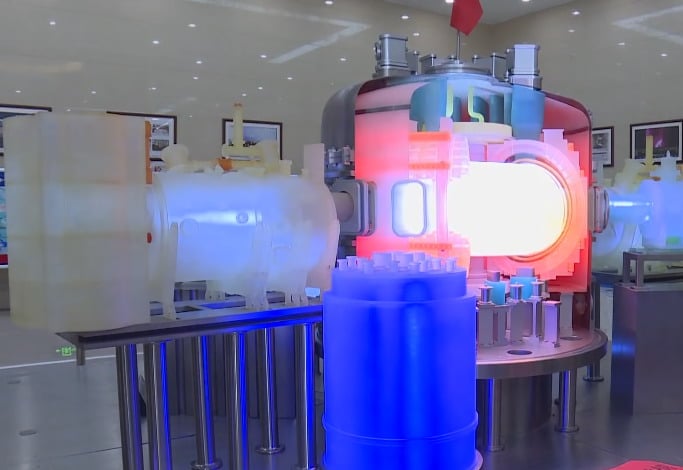Nuclear Fusion vs Nuclear Fission

Nuclear fusion and nuclear fission are two nuclear reactions based on chemical and physical processes that produce energy from atoms.
What is Nuclear Fission?
Nuclear fission is the nuclear reaction that splits large and unstable nuclei into smaller nuclei. At the same time, loads of energy are released.
All the energy produced today on our planet in nuclear power plants is generated by the nuclear fission reaction.
Nuclear fission can occur in two different ways: spontaneously, when fission is unforced and happens by itself (very rare), or by absorbing a neutron, which effectively splits a nucleus making it even less stable.
In real life, spontaneous fission is very rare, and this is the reason why we produce the nuclear fission reaction in nuclear reactors.
The Nuclear Fission Reaction
To get the process started, we have to use neutrons. As fuel for the nuclear fission reaction, we use large unstable nuclei like uranium (Uranium-235) or plutonium (Plutonium-239).
To initiate the nuclear fission reaction, we fire a relatively slow-moving neutron in the nucleus of the uranium.
The neutron addition to the unstable nuclei of uranium will split it apart into two smaller nuclei. In the process, three more neutrons are released along with loads of energy in the form of gamma radiation.
Each of the neutrons released in the process will repeat the nuclear fission reaction all over again with other uranium nuclei. These are smaller nuclei, energy and neutrons are produced again, and this allows the process to start over.
Nuclear fission leads to a chain reaction, where the first fission can trigger more fission.
If the nuclear fission reaction is not controlled properly, the whole system can quickly get out of control, releasing huge amounts of energy (the nuclear bomb).
In nuclear power plants, the nuclear fission reaction is controlled using control rods, which can be lowered into the reactor to absorb neutrons and slow down the nuclear reaction.
The energy produced through nuclear fission in nuclear power plants is used to boil water, and the steam produced spins a turbine to generate clean electricity.
What is Nuclear Fusion?
Nuclear fusion is the nuclear reaction in which two lighter nuclei join or fuse to form a single larger nucleus.
Example
Two hydrogen nuclei like hydrogen 1 and hydrogen 2, can fuse together to form a larger nucleus helium 3. This nuclear process releases tons of energy and is the process that fuels all the stars in the known universe.
As we can see, fusion is opposite to fission, because nuclear fusion fuses two or more nuclei to form a single and heavier nucleus.
Nuclear fusion can also be found in the Sun because this is the nuclear reaction that powers our star and fuses four atoms of hydrogen to produce one atom of helium.
Fusion in the Sun is a nuclear reaction that makes atomic nuclei of hydrogen (deuterium and tritium) collide at a high speed and join to form a new type of atomic nucleus (helium) and one neutron. During this process, matter is not conserved because some of the matter of the fusing nuclei is converted to photons, which produces the light.
During the thermonuclear reaction (fusion) a huge amount of energy is released under the form of heat and light.
The Nuclear Fusion Reaction
Nuclear fusion only works with smaller atoms like hydrogen. Hydrogen is so light because in its nucleus, we find only one proton (protons are positively charged composite particles).
If we force two hydrogen atoms together, they will repel each other due to their similar charge (+).
If we talk about their nucleus, the Coulomb force is responsible for the fact that similarly charged particles repel each other.
Like fission, nuclear fusion needs a force to overcome the Coulomb force.
This happens by speeding up the atomic nuclei, and to achieve this, they are subjected to great heat and/or pressure.
Less heat is needed if more pressure is available.
Because here on Earth, we can’t replicate the humongous pressure in the Sun’s core (265 billion bar), we have to increase the temperature up to 150 million °C.
Reaching such an impressive temperature in a nuclear fusion reactor here on the planet would overcome the Coulomb force, and will make the nuclei fuse to produce a heavier nucleus with the release of huge amounts of energy.
In May, 2021, the Experimental Advanced Superconducting Tokamak (EAST) in China, managed to achieve and maintain for 101 seconds a plasma temperature of 120 million °C, and a temperature of 160 million °C for another 20 seconds.
This means that humanity already managed to create and maintain here on the planet a temperature that is over ten times hotter than the Sun.
What is the Difference Between Nuclear Fission and Nuclear Fusion?
According to Energy.Gov, fission and fusion ate two physical processes producing energy from atoms.
Fission splits a larger atom into two or more smaller atoms, while fusion fuses or joins two or more lighter atoms into a larger and heavier atom.
Fission uses as fuel, fossil fuels, mainly Uranium-235 or Plutonium-239, and recently Thorium-232. All these nuclear fuels are limited resources, while fusion uses hydrogen that is a renewable resource.
Beside clean energy, the byproduct of fission is used nuclear fuel that needs to be properly disposed because it’s very harmful for any living being, while the byproduct of fusion is only helium and a huge amount of clean energy.
Despite the hazardous nuclear waste produced in the nuclear fission reaction, this type of nuclear reaction is very popular on the planet (is used in almost all nuclear power plants), while the nuclear fusion reaction is still under development because is way more complex than we thought.
In terms of energy generation, fission is 1 million times greater than other energy sources (fossil fuels like coal, oil or natural gas), while fusion is 3 to 4 times greater than fission.
Is Nuclear Fusion Safer than Nuclear Fission?
Instead of splitting atoms like fission, the nuclear fusion reaction fuses or joins two or more lighter atoms (hydrogen), to produce a larger and heavier atom (helium).
Nuclear fusion is much safer than nuclear fission because instead of producing energy and dangerous nuclear waste, fusion produces only energy and helium.
The main problem with nuclear fission is the nuclear waste produced during the fission reaction.
This problem has been overcome with fusion. However, nuclear fusion still needs a few more decades to finally become a major source of energy for mankind.
Is Nuclear Fusion or Fission More Powerful?
Nuclear fusion is way more powerful and cleaner than nuclear fission.
Through nuclear fission we release up to 1 million times more energy per atom than fossil fuels, and through nuclear fusion we can release 3 to 4 million times more energy than fossil fuels per atom.
This means that nuclear fusion releases 3 to 4 times more energy per atom than nuclear fission.
Why is Nuclear Fusion Not Used?
By using nuclear fusion here on Earth, we are trying to replicate the thermonuclear reaction in the Sun. This involves extremely high temperatures (150 million degrees Celsius), and a very complex process that is not yet fully understand by mankind.
Fusion offers the prospect of an almost inexhaustible source of clean energy for us, however, creating the conditions for the fusion reaction here on the planet presents a potentially insurmountable scientific and engineering challenge.
A recent experiment has shown that nuclear fusion can be achieved on the planet, but is not yet ready to become a major source of power for mankind.
Conclusion
It seems that we have to wait a few more decades until fusion will become successful at commercial scale, however, if we can get rid of the dangerous nuclear waste produced by fission, it will certainly worth the wait.







